Three brands. Three different industries. One common strategy that transformed their growth.
- Castlery (furniture): 5X growth in U.S. orders through strategic deal site partnerships
- Merry People (footwear): Doubled partnership revenue across three countries with content marketing partnerships
- RingCentral (B2B software): Redesigned referral program drove measurable growth by turning customers into advocates
These partner marketing examples represent a fundamental shift in how brands scale in 2025. While competitors pour budgets into paid ads with diminishing returns, smart brands are building diverse partnership ecosystems that deliver sustainable, measurable growth.
The challenge isn’t simply finding partners—it’s knowing which types of partnerships will drive real results for your specific business goals. Should you focus on influencer collaborations? Content partnerships? B2B alliances? Customer referrals? The answer isn’t one or the other—it’s building the right mix.
This comprehensive guide examines 12 proven partnership marketing examples that are driving results across industries. You’ll discover specific strategies, performance data, and implementation insights from brands that have cracked the code on scalable partnership growth.
Types of partnership marketing that drive measurable results
The road from discovery to purchase is anything but direct. Most consumers now research products at least three separate times before deciding to buy, engaging with a mix of websites, social media, word-of-mouth, and even in-store experiences.
For brands, this means meeting potential customers at numerous touchpoints to remain visible, credible, and relevant throughout their decision-making process. Building a diverse partner portfolio helps brands build trust, stay relevant, and turn engagement into action.
Here’s a closer look at 12 affiliate partnership types that are redefining success. Each type highlights proven strategies and actionable insights, helping you discover fresh ways to optimize your approach.
| Partner type | What is it | Where it works best |
| Influencers and content creators | Creators with loyal audiences who promote products via content | Beauty, fashion, wellness, food |
| Content partners | Publishers who write product-focused content with affiliate links | High-consideration items: tech, appliances |
| Customer referral programs | Customers who earn rewards for bringing in others | Apps, subscriptions, fan-driven products |
| Brand ambassador programs | Long-term promoters (fans or creators) who represent the brand | Lifestyle, fashion, fitness |
| Strategic B2B partnerships | Two businesses collaborate to co-sell or co-market | SaaS, e-commerce, and complementary services |
| Native software integrations | Apps or platforms that connect directly to support the user flow | CRMs, booking systems, productivity tools |
| Loyalty and rewards programs | Perks-based systems for repeat purchase or engagement | Retail, food delivery, subscription services |
| CSR partnerships | Collaborations with nonprofits to promote shared causes | Sustainable, ethical, value-based brands |
| Mobile affiliate programs | Mobile-first strategies (SMS, app installs, etc.) | Retail, gaming, travel, and fast-moving deals |
| Review and comparison sites | Platforms offering detailed product analysis and rankings | Tech, health, finance, high-research items |
| Deals and coupon sites | Offer-based promotions through savings platforms | E-commerce during holidays or clearances |
| Email marketing partners | Newsletters or curated email promotions | Niche markets or product launches |
1. Influencer marketing campaigns: Trust builders in the spotlight
Influencers and content creators are individuals with loyal online audiences who promote products through engaging content tailored to niche communities. Their endorsements often feel more trustworthy than ads, helping drive conversions through authenticity and relevance.
How it works
Brands provide creators with affiliate links or discount codes. These links are integrated into content formats that match the creator’s platform. For instance, a skincare routine on TikTok, a product review on YouTube, or a daily look post on Instagram. When a follower makes a purchase through the link, the creator earns a commission.
Benefits
- Builds loyalty and trust with niche audiences: Influencers speak directly to tight-knit communities who trust their recommendations.
- Delivers authentic, engaging content: Personalized posts and videos feel native to the platform and resonate more than ads.
- Boosts engagement and conversion: Well-aligned endorsements encourage action from audiences who see creators as peers.
Where this works best
- Useful for brand or product launches where credibility and social proof are key.
- Ideal for categories with strong visual appeal or lifestyle tie-ins, such as beauty, wellness, fashion, and food.
- Effective for brands looking to build quick traction with highly engaged communities.
What this looks like in action
Solo Stove makes portable, smokeless stoves for outdoor cooking. To grow brand awareness without increasing affiliate spending, it teamed up with lifestyle and outdoor creators who focused on experience-driven content—such as families roasting marshmallows around a Solo Stove.
Image source: @shaynamarie
By prioritizing this content-first strategy and broadening its creator mix, Solo Stove saw the following improvements:
- Affiliate channel revenue: 72 percent increase
- Return on ad spend (ROAS): 85 percent increase
- Revenue growth from 2021 to 2023: 100 percent increase
- Productive publishers: 74 percent boost
- Affiliate spend: 7 percent decrease
The team’s bold approach to ‘set old marketing strategies ablaze,’ as one member put it, has paid off—partnerships now drive at least 11 percent of the company’s total revenue.
2. Content partnerships: Champions of purchase intent
Content partners (a.k.a. commerce content publishers) are digital publishers that create commerce-focused articles such as reviews, gift guides, and “best of” lists that help customers make informed purchase decisions. These placements deliver long-term value through SEO, authority, and affiliate program revenue.
How it works
A brand partners with a publisher such as Better Homes & Gardens or Wirecutter to be featured in an editorial article. These pieces are optimized for search and often cater to readers actively researching what to buy. When a user clicks an affiliate link and makes a purchase, the publisher earns a commission while the brand benefits from exposure and conversions.
Benefits
- Earns long-tail SEO traffic: These articles continue to drive traffic and revenue for months, sometimes even years after publication. Unlike paid ads, they don’t disappear when the budget runs out.
- Builds trust through editorial authority: Readers tend to trust the recommendations of established publishers, especially when the content is educational or based on thorough product testing.
- Improves consideration and conversion: Long-form reviews and comparisons guide consumers through complex buying decisions, making them useful for higher-ticket or niche items.
Where this works best
- Ideal for high-consideration purchases such as electronics, appliances, or specialty apparel.
- Especially effective when expanding into new regions or demographics and looking to build early trust.
- Works well for brands with strong product-market fit that benefit from in-depth editorial explanation.
What this looks like in action
Merry People, an Australian rain boot brand, partnered with The New York Times to be featured in a guide about stylish, functional rainwear. Rather than relying on splashy ad campaigns, the brand focused on search-optimized, trust-based content marketing.
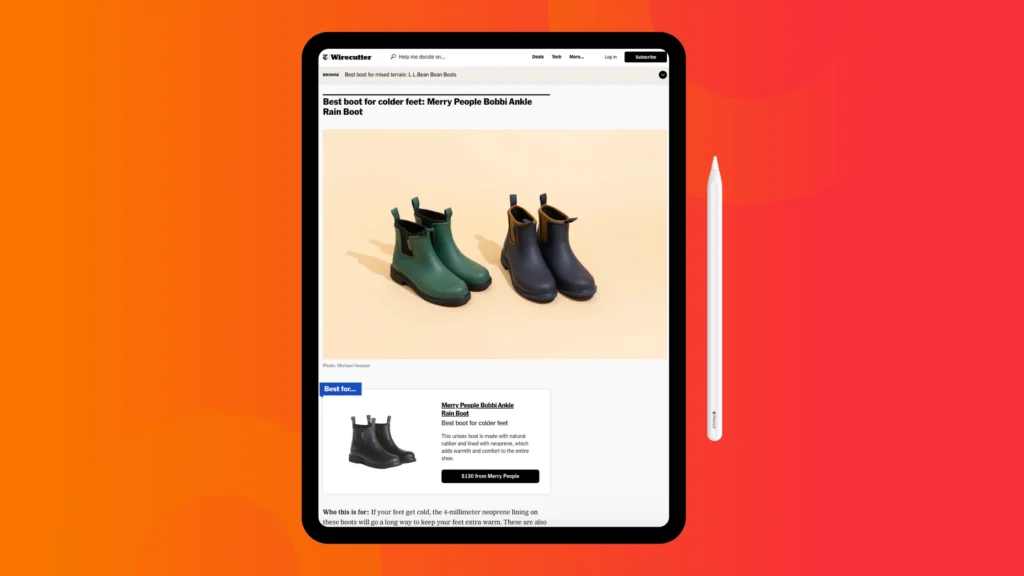
Image source: The New York Times
To scale internationally, Merry People launched a partnership program through impact.com, combining premium publisher placements with niche community outreach. That New York Times feature continued driving weekly sales over a year after it was published, while blogs such as North Shore Mums (with 73,000 monthly visits) became top-performing affiliates by connecting with core audiences of women in their thirties and forties.
Results from this two-pronged strategy include:
- Onboarding 334 new partners
- Doubling partnerships’ revenue across Australia, the US, and the UK
- Increasing return on ad spend (ROAS) by 25 percent
- Achieving 50 percent year-over-year partner growth
- Growing cashback and loyalty affiliates to account for 35 percent of partner-driven revenue, with a 42.5 percent higher conversion rate compared to the previous year
Through these outcomes, Merry People scaled their business while staying true to their grassroots values.
3. Customer referral and advocate programs: Turning loyalty into leads
Customer referral and advocate programs turn loyal customers into active promoters by rewarding them for sharing the brand with friends, family, or colleagues. These marketing partnerships rely on trust, since people are more likely to buy when a product is recommended by someone they know.
How it works
Brands give customers unique referral links or codes to share. When someone makes a purchase using that link, both the referrer and the new customer typically receive a reward—such as credit, cash, or loyalty points. Many programs also add reward tiers, bonuses, or gamified elements to encourage consistent engagement.
Benefits
- Builds trust through peer recommendations: Nearly 9 in 10 consumers say recommendations are important in their buying decisions.
- Drives cost-effective growth: You only pay when referrals convert, making this cheaper than most paid channels.
- Deepens customer engagement: Loyal customers feel more invested when they’re rewarded for sharing something they already love.
Where this works best
- Drives growth for subscription-based services or apps where engaged users naturally promote the product, and recurring revenue amplifies the value of each referral.
- Builds momentum for brands with strong customer satisfaction by turning enthusiastic reviews and word-of-mouth into measurable growth.
- Works well in competitive markets, where a trusted recommendation stands out more than a traditional ad and helps convert hesitant buyers.
What this looks like in action
RingCentral, a cloud communications platform, redesigned its referral program to improve scale and performance. By embedding referral prompts into its product, offering dynamic reward structures, and triggering outreach based on customer behavior, it turned satisfied users into motivated advocates.
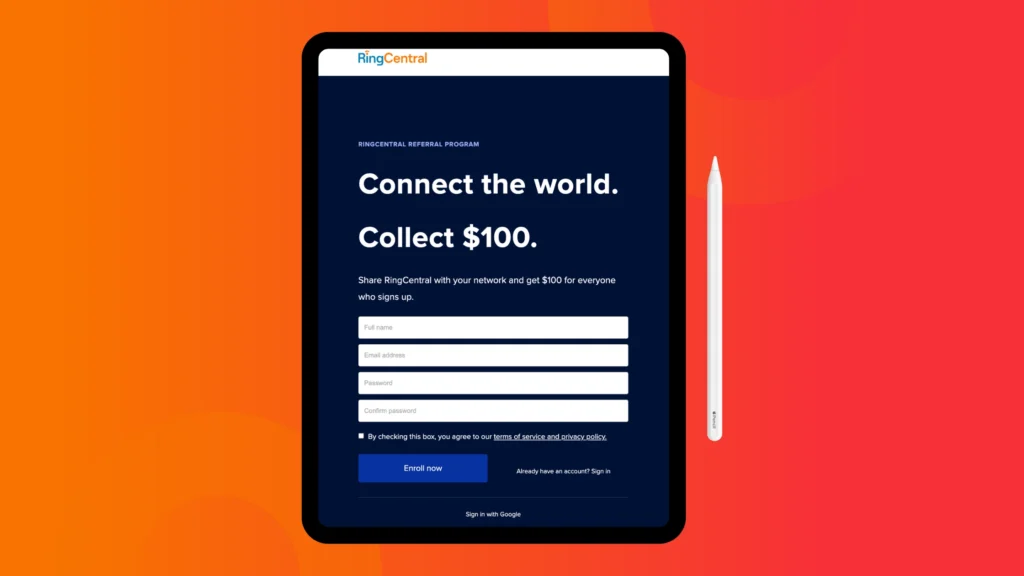
Image source: RingCentral’s Referral Program
RingCentral users who tap into the brand’s referral program can earn a $100 gift card. Here’s how it works:
- Enroll: Customers provide their details to join the referral program.
- Enlighten: A personalized link is shared to introduce RingCentral’s cloud communications platform.
- Earn: A $100 gift card is awarded for every successful referral that leads to a sign-up.
The upgraded program helped drive growth by aligning internal teams, increasing engagement, and making referral activity more visible and actionable.
4. Brand ambassador programs: Your brand’s personal storytellers
Brand ambassador programs build long-term relationships with loyal customers, micro-influencers, or community figures who authentically promote a brand. These ambassadors represent the brand consistently across channels and help build credibility over time.
How it works
Brands invite loyal customers, micro-influencers, or niche community leaders to become ambassadors. Once selected, ambassadors receive perks such as free products, early access to launches, exclusive discount codes, and sometimes monetary rewards. In exchange, they create content, share personal testimonials, or participate in brand events.
Benefits
- Delivers consistent brand promotion: Ambassadors create content on a regular basis, keeping the brand visible over time.
- Builds long-term loyalty: Ongoing relationships with real customers help deepen emotional investment in the brand.
- Scales peer-to-peer promotion: Ambassadors introduce products to highly engaged audiences through relatable, word-of-mouth marketing
Where this works best
- Best suited for lifestyle, fashion, fitness, or wellness brands that benefit from long-term social proof and recurring exposure.
- Ideal for companies with strong product-market fit looking to scale without excessive reliance on traditional paid media.
- This is especially effective when cultivating an engaged community that aligns with your brand’s values, whether sustainability, performance, or self-expression.
What this looks like in action
Vivaia, a sustainable footwear brand, partners with content creators who authentically reflect its eco-conscious values. For example, in this Instagram post, fashion and lifestyle influencer Mariam Kurtanidze featured Vivaia’s Margot Mary Janes, highlighting their ballet-flat feel, everyday comfort, and iconic Ruby Red color.
Image source: @mariamiikurtanidze
By weaving the shoes into her personal style narrative, Mariam offers her audience an authentic glimpse into Vivaia’s offerings, exemplifying a strong alignment between brand and ambassador. The brand experienced track-stopping results by focusing on this partner type:
- 13.5k clicks
- 450k total engagement
- 4m impressions
5. Strategic B2B partnerships: Allies for scalable success
Strategic B2B partnerships are long-term collaborations between businesses with aligned goals, typically in adjacent or complementary industries. These partnerships aim to increase revenue, share audiences, and deliver added value—all without competing directly.
How it works
Businesses identify partners that offer complementary services, tools, or audiences. They then structure co-marketing efforts such as joint landing pages, referral links, webinars, or bundled offers to drive traffic and sales.
Partnerships can be tracked through affiliate links or custom referral dashboards, and revenue is typically split based on performance or contribution.
Benefits
- Expands reach into new audiences: B2B partners often bring in target audiences that overlap but don’t compete.
- Reduces spend by sharing resources: Campaign costs, tools, and creative assets are often split.
- Builds brand credibility through association: Being aligned with a known company boosts perceived trust.
- Encourages collaboration and innovation: These partnerships often surface new ideas and bundled offerings.
Where this works best
- Effective when introducing complementary products or services.
- Ideal for industries with overlapping customer bases, such as SaaS or e-commerce.
What this looks like in action
A great example comes from Getty Images’ strategic partnership with Canva. Canva users seamlessly access Getty’s vast repository of high-quality images directly within the platform, enhancing design capabilities without disrupting workflows.
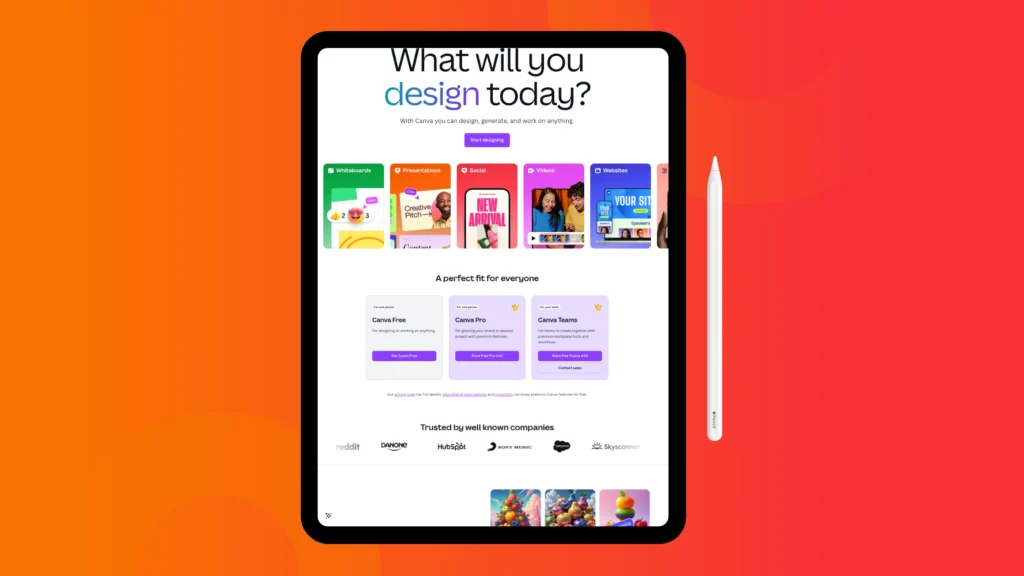
Image source: Canva.com
This integration goes beyond providing images; it enables Canva to deliver a richer creative experience for its users while maximizing Getty Images’ reach. The success lies in the simplicity of the user experience and the mutual focus on value-added services.
This shared success is also evident in Getty Images’ partnership with TikTok, where businesses can tap into an extensive content library directly within TikTok’s ad platform to create relevant, impactful campaigns.
6. Native software B2B partnerships: Tech that connects and converts
Native software integrations are built-in connections between platforms that create a smoother, more valuable user experience. Instead of interrupting the journey, they let customers take meaningful actions such as booking, buying, or exploring—without ever leaving the app.
How it works
Two companies integrate their products so users can engage directly within one app—such as purchasing tickets or syncing data—without switching tools. The referring partner earns a commission through backend tracking, typically via APIs or SDKs. The experience feels seamless to the user but delivers measurable results to the brand.
Benefits
- Creates a seamless user experience: Users can take action without switching platforms, reducing friction and increasing satisfaction.
- Improves accuracy and speed: Real-time syncing eliminates delays and manual errors, keeping performance data reliable.
- Saves time through automation: Built-in connections reduce manual tasks, letting teams focus on strategy instead of operations.
- Scales efficiently: Once live, integrations can be extended across tools, platforms, or markets without major rework.
Where this works best
- Ideal for businesses managing large-scale affiliate programs with multiple platforms.
- Effective for streamlining workflows when using tools such as CRMs, email marketing software, or e-commerce platforms.
- Works well for companies aiming to unify reporting and performance metrics in one location.
What this looks like in action
Ticketmaster partnered with Spotify to connect users’ listening habits with ticket purchases. When fans saw upcoming events for their favorite artists inside the app, they could buy instantly—no redirects or extra steps. The result: a 20 percent lift in conversions and 32 percent year-over-year revenue growth.
Travel brands are also finding innovative ways to enhance user experience and boost conversions through seamless technology. A prime example is Travel Arrow, which simplifies flight comparisons by embedding itself into users’ browsing routines. Here’s how it works:
- Download: The extension is easily accessible and installed from the Chrome Web Store.
- Integrate: Once installed, it syncs with Google Flights, channeling users’ searches to top travel platforms.
- Compare: After a search, a pop-up provides direct links to the same flights on Skyscanner, Kayak, Expedia, and Southwest Airlines (for domestic routes), allowing travelers to compare and purchase prices instantly.
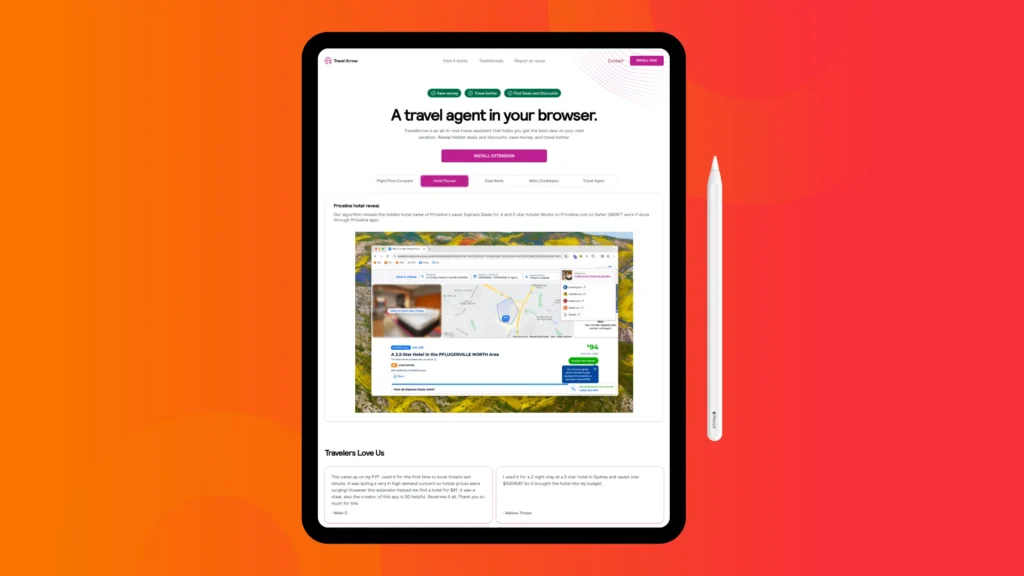
Image source: Travel Arrow
7. Loyalty and rewards marketing partnerships: Building bonds through benefits
Loyalty and rewards partnerships incentivize repeat engagement by offering customers points, cashback, or exclusive perks for actions such as purchasing, referring friends, or completing challenges. These programs tap into buyer psychology—customers appreciate rewards, and brands benefit from increased retention and lifetime value.
How it works
Customers earn rewards through a point-based or tiered system as they interact with the brand. These rewards can be redeemed for discounts, free products, or VIP experiences. Many programs also integrate with referral systems, encouraging members to bring in new customers while enjoying additional benefits.
Benefits
- Increased customer retention: Rewarding ongoing engagement keeps customers coming back and boosts lifetime value.
- Strengthens emotional connection: Exclusive perks and recognition build loyalty that goes beyond price.
- Unlocks valuable data: Tracking rewards and redemption offers insight into customer behavior and preferences.
- Differentiates in crowded markets: A well-structured loyalty program makes your brand harder to switch away from.
Where this works best
- Effective for industries with frequent purchase cycles, such as retail, food services, or subscription models.
- Ideal for brands aiming to reduce churn and increase repeat transactions.
- When introducing new products, as existing customers are more likely to explore additional offerings if rewards are tied to the purchases.
What this looks like in action
Honey, a PayPal-owned browser extension, partners with e-commerce brands to drive purchases through its rewards program, Honey Gold. Users earn points by shopping with affiliate-linked retailers, which can be redeemed for gift cards or PayPal cash. This approach incentivizes purchases and fosters customer loyalty by providing tangible rewards for shopping activities.
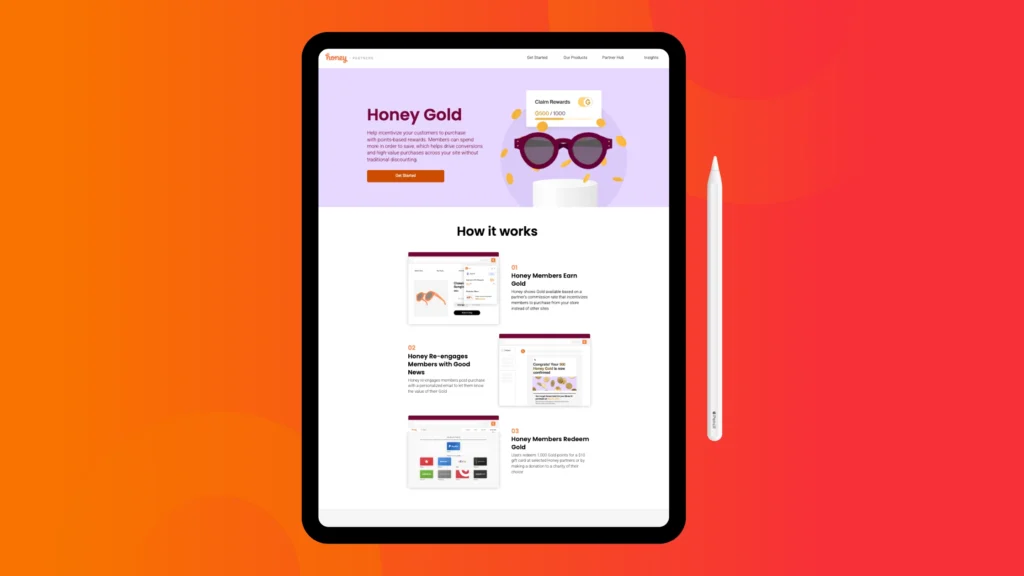
Image source: Honey Gold
8. Corporate social responsibility (CSR) partnerships: Good deeds that resonate
CSR partnerships connect brands with nonprofits or mission-driven organizations to support causes that matter—from clean water to animal conservation. These strategic partnerships go beyond profit to build community goodwill and strengthen brand trust.
How it works
Brands team up with nonprofit partners or cause-aligned organizations to support shared missions. This could mean donating a percentage of affiliate revenue, launching co-branded campaigns, or creating product lines tied to a charitable cause. Nonprofit ambassadors and mission-based influencers may also play a role in promoting the partnership.
Benefits
- Deepens emotional loyalty: Customers are more likely to stick with and talk about brands that align with their values.
- Taps into new, purpose-driven audiences: CSR partnerships attract people who care more about impact than discounts.
- Builds brand credibility: Partnering with respected nonprofits signals real commitment, not performative branding.
- Drives meaningful engagement: Customers aren’t just buying a product — they’re joining a mission.
Where this works best
- Great for brands that already center sustainability, ethics, or community-building in their identity.
- Ideal for raising awareness during launches or rebrands when you want to lead with values.
- Works especially well in markets where consumer trust plays a big role in purchase decisions.
What this looks like in action
Ivory Ella, an apparel brand, gives 10 percent of all profits to organizations such as Save the Elephants and has since donated over $2.2 million.
The brand partnered with agency BVAccel to scale its charitable affiliate program and grow in new markets. The team focused on purpose-driven partnerships, working with micro-influencers and college ambassadors to promote products and mission-driven messaging.

Image source: @synonymof_moonlit feature on @ivoryella
This strategy delivered measurable impact: 11 percent of total revenue came through the partner channel, the brand achieved a 19x return on ad spend (ROAS), and saw a 56 percent year-over-year revenue increase in Q4.
By blending commerce with purpose, Ivory Ella proved that mission-driven marketing can fuel both impact and business growth.
9. Mobile affiliate partnerships: Reach your audience on the go
Mobile affiliate partnerships involve working with affiliates or platforms that specialize in mobile-specific channels such as apps, SMS, and in-app advertising, to reach and convert mobile-first users. With more than half of global e-commerce happening on mobile, these partnerships are critical for engaging users where they’re most active.
How it works
Brands team up with mobile-first affiliates such as app publishers, SMS platforms, and mobile ad networks to drive installs, in-app purchases, or traffic to mobile-optimized pages. These campaigns use push notifications, in-app placements, or SMS links and often provide real-time analytics to help optimize performance.
Benefits
- Reach mobile-first audiences: Tap into the habits of users who primarily browse and shop on their phones.
- Boost engagement with targeted formats: Push notifications, SMS, and in-app placements deliver timely, relevant offers.
- Drive app installs and activity: Campaigns can be structured around downloads, signups, or specific in-app actions.
- Enable real-time campaign optimization: Mobile platforms provide instant performance data, so you can adjust on the fly.
Where this works best
- Ideal for brands with mobile apps looking to increase downloads and lifetime value.
- Useful for industries such as gaming, travel, and retail, where mobile conversion is key.
- Works well for time-sensitive campaigns where instant engagement matters (e.g., flash sales or app-only discounts).
What this looks like in action
Sam’s Club integrated Button’s tech to reroute mobile web users to its app, where shopping is faster and smoother. This shift helped them boost mobile affiliate revenue by 165 percent and increase conversion rates by 81 percent, proving the value of platform-specific performance tweaks.

Image source: Button
10. Content partnerships through review and comparison websites: Decision making made simple
Review and comparison websites evaluate and rank products or services, guiding consumers through detailed analyses to aid in decision-making. These platforms often monetize through affiliate partnerships, earning commissions for referrals or conversions.
How it works
These platforms compile data, user reviews, and expert evaluations to create comparisons across products or services in the same category. Affiliate links are embedded in recommendations, driving traffic to the brand’s website while enabling website owners to earn commissions for resulting purchases. This method benefits both the consumer and the brand.
Benefits
- Builds trust with in-depth analysis: These platforms help buyers feel confident by offering detailed, unbiased product breakdowns.
- Attracts ready-to-buy traffic: Shoppers visit with high intent, often at the decision-making stage.
- Increases product visibility: Your brand shows up in top-ranked lists, drawing attention during competitive searches.
- Generates ongoing revenue: Once published, review pages continue driving conversions without additional ad spend.
Where this works best
- Effective for brands in competitive niches where options may overwhelm consumers.
- Ideal for higher-cost items where buyers heavily rely on research prior to purchase.
- Useful during product launches, providing a platform for reviews and rankings.
What this looks like in action
Dog Food Advisor has earned a reputation for thorough, research-based rankings of pet food brands. Its transparent approach, including ingredient breakdowns and recall tracking, builds trust with pet owners. These reviews also generate affiliate revenue through embedded, high-intent links.
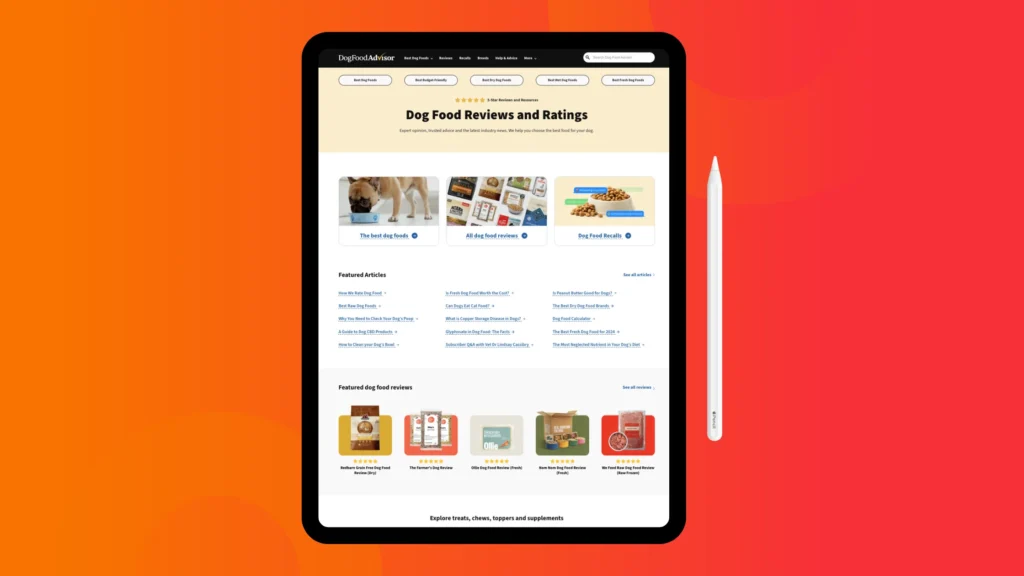
Image source: Dog Food Advisor
11. Deals and coupon affiliate partnerships: Savings that spark action
Deals and coupon sites are platforms that feature promo codes, flash sales, and time-limited discounts from a wide range of brands. They attract price-sensitive shoppers who are ready to buy but looking for the best deal, often converting in just a few clicks.
How it works
Brands provide exclusive promo codes or discounts to deal platforms such as RetailMeNot, Honey, or ShopBack. These offers are promoted through newsletters, search engine results, and mobile alerts, reaching shoppers who are actively looking for savings. When a user clicks through a tracked link and completes a purchase, the platform earns a commission.
Benefits
- Capture high-intent shoppers: These users are ready to buy—they’re just looking for the right offer.
- Lift conversion rates: Discounts and promo codes remove final barriers to purchase.
- Reach new, price-sensitive audiences: Deal hunters might not have discovered your brand otherwise.
- Drive exposure on high-traffic platforms: Coupon and promo sites see massive daily visits, boosting brand awareness.
Where this works best
- Well-suited for seasonal campaigns or limited-time promotions where urgency is key.
- Ideal for e-commerce brands aiming to convert budget-conscious shoppers.
- Useful for clearing out excess inventory with minimal advertising spend.
What this looks like in action
Castlery, a digital-first furniture brand, partnered with RetailMeNot to boost visibility during major seasonal sales. These promotions featured limited-time deals tailored to RetailMeNot’s audience—shoppers looking to save on home essentials.
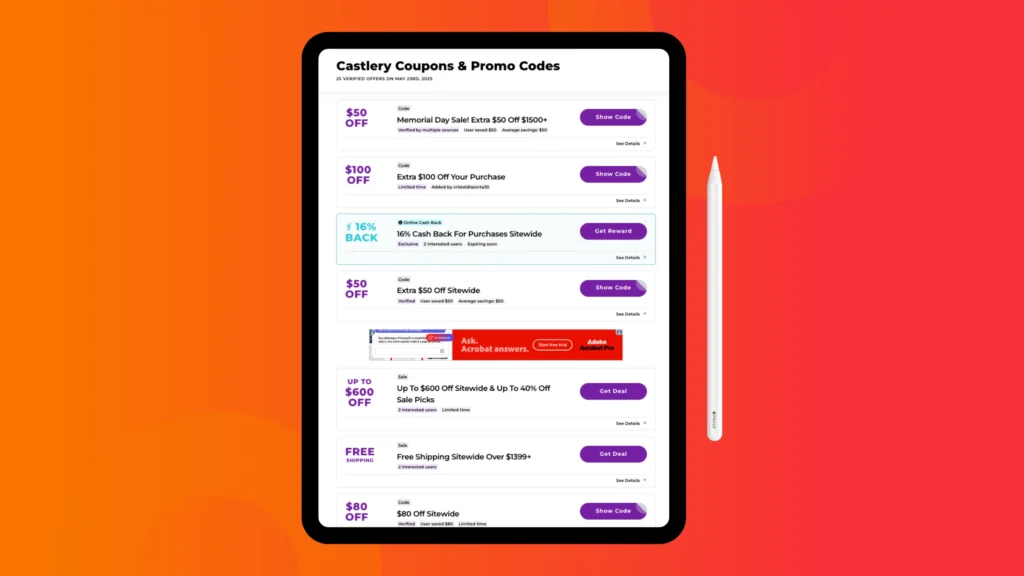
Image source: RetailMeNot
To support performance, Castlery used impact.com’s reporting suite to monitor redemptions and optimize campaign timing. The partnership helped Castlery drive a 12 percent increase in average order value, scale up its partner roster to over 300, and grow U.S. orders by 5X in just one quarter.
12. Email marketing partnerships: Personal connection, direct results
Email marketing partners specialize in reaching targeted audiences through curated newsletters and promotional campaigns. By leveraging personalized, data-driven messaging, these partners effectively promote affiliate offers, driving traffic and conversions for brands.
This approach taps into the high ROI of email marketing—averaging $36 for every $1 spent—by integrating affiliate campaigns directly into trusted email content.
How it works
Brands collaborate with email marketers who feature their products or offers in newsletters or dedicated email blasts. These emails include affiliate links or calls-to-action (CTAs) that guide readers to the brand’s website, encouraging conversions. Email marketers often segment their subscriber lists to tailor content, ensuring relevance and increasing engagement.
Benefits
- Deliver highly personalized content: Segmented lists let brands send messages that speak directly to specific groups.
- Generate strong ROI: Email remains one of the top-performing affiliate channels, often delivering $36 for every $1 spent.
- Build lasting relationships: Consistent, high-value emails help brands stay relevant in subscribers’ inboxes.
- Track and improve performance: Clear metrics such as open rates and click-throughs allow for easy optimization.
Where this works best
Ideal for industries such as e-commerce, travel, and subscription services aiming to:
- Retarget warm leads with personalized offers.
- Promote limited-time deals or product launches.
- Maintain ongoing engagement with a dedicated audience.
What this looks like in action
Brands aiming to reach a broad, engaged audience through email marketing can partner with thought leaders who have substantial subscriber bases. For instance, Melissa K. Norris, a homesteading expert, offers the Pioneering Today newsletter, which shares traditional living tips and product recommendations with her dedicated followers.

Image source: Pioneering Today
FAQs
Partnership marketing is when brands team up with third parties to promote their products through affiliate links or content. Partners earn commissions for driving traffic or sales, making it a win-win model.
They place your brand in trusted editorial content such as reviews and gift guides, helping drive conversions. These placements also deliver long-term SEO value and build credibility.
Influencers create authentic content that resonates with loyal, niche audiences. Their recommendations often convert better than traditional ads.
Common partner marketing examples include influencer collaborations, commerce publishers, referral programs, mobile affiliates, coupon sites, loyalty partners, and tech integrations. Each plays a different role in the customer journey—from discovery to decision.
Referral programs are powered by peer trust. People are far more likely to try a product when it’s recommended by someone they know. And when both sides get something valuable in return—store credit, a discount, or even cash, it’s an easy win for everyone involved.
CSR partnerships are built around shared values. Brands team up with nonprofits or cause-driven groups to do good while building awareness. Standard partnerships focus more on revenue, traffic, or leads. CSR builds brand loyalty in a deeper, emotional way.
Marketing partnerships are your diversified growth engine
The brands seeing steady, measurable results today aren’t relying on one partner type—they’re building a portfolio. Influencers drive trust. Publishers bring authority. Referral programs tap into real-life word-of-mouth.
When these are layered with intention, the result is broader reach, higher conversion, and steady growth that isn’t tied to one channel or campaign. That’s what makes these partner marketing examples worth studying and replicating. But building and managing a mix like this takes the right tools.
That’s where platforms like impact.com come in—giving you the infrastructure to manage every step of the partner journey, from discovery to performance tracking.
If you’re ready to build a program that works long-term, these guides can help you get started:
- Your how-to guide to managing partnerships throughout their life cycle (infographic)
- Best practices: Discover & Recruit (ebook)
- Best practices for tracking your partnerships (ebook)
- Best practices for engaging partners (ebook)
- Best practices to protect and monitor your partnerships (ebook)
- Best practices for optimizing your partnerships (ebook)




